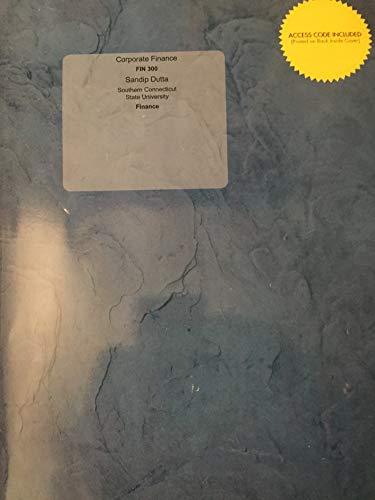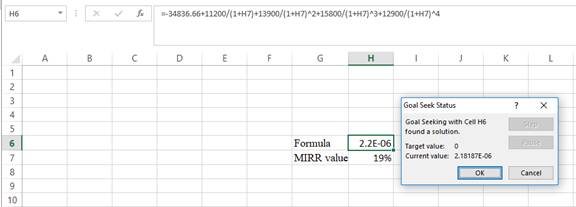
Concept explainers
To calculate: The MIRR (Modified
Introduction:
MIRR is the Modified internal rate of return, which is a financial measure of attracting the investments. It is utilized in the capital budgeting to rank the alternative investments of same size.
Answer to Problem 19QP
The MIRR for the project using the discounted approach is 19.29%, reinvestment approach is 15.19%, and the combination approach is 14.338%.
Explanation of Solution
Given information:
Company S is assessing a project, where the cash flows are$11,200, $13,900, $15,800, $12,900, and -$9,400 for year 1, 2, 3, 4, and 5 respectively. The initial cost is $29,000.
Discounted approach:
In this approach, compute the negative cash outflows value at the year 0. On the other hand, the positive cash flows remain at its time of occurrence. Hence, discount the cash outflows to year 0.
Hence, the discounted cash flow at time 0 is -$34,836.66.
Equation of MIRR in discounted approach:
Compute MIRR using a spreadsheet:
Step 1:

- Type the equation of
NPV in H6 in the spreadsheet and consider the MIRR value as H7.
Step 2:

- Assume the MIRRvalue as 10%.
Step 3:

- In the spreadsheet, go to data and select What-If-Analysis.
- In What-If-Analysis, select goal seek.
- In “Set cell”, select H6 (the formula).
- The “To value” is considered as 0 (the assumption value for NPV).
- The H7 cell is selected for the 'By changing cell'.
Step 4:

- Following the previous step, click OK in the goal seek status. The goal seek status appears with the MIRRvalue.
Step 5:

- Thevalue appears to be 19.2878331713426%.
Hence, the MIRRvalue is 19.29%.
Reinvestment approach:
In this approach, compute the
Hence, the reinvesting cash flow at time 5 is $58,806.82.
Equation of MIRR in reinvestment approach:
Compute the MIRR:
Hence, the MIRR is 15.19%.
Combination approach:
Note: In this approach, compute all the cash outflows at year 0 and all the
Hence, the total
Hence, the value of total cash inflows is $68,206.82.
Equation of MIRR using combination approach:
Compute the MIRR:
Hence, the MIRR is 14.38%.
Want to see more full solutions like this?
Chapter 9 Solutions
Corporate Finance Southern Connecticut State University
 Essentials Of InvestmentsFinanceISBN:9781260013924Author:Bodie, Zvi, Kane, Alex, MARCUS, Alan J.Publisher:Mcgraw-hill Education,
Essentials Of InvestmentsFinanceISBN:9781260013924Author:Bodie, Zvi, Kane, Alex, MARCUS, Alan J.Publisher:Mcgraw-hill Education,

 Foundations Of FinanceFinanceISBN:9780134897264Author:KEOWN, Arthur J., Martin, John D., PETTY, J. WilliamPublisher:Pearson,
Foundations Of FinanceFinanceISBN:9780134897264Author:KEOWN, Arthur J., Martin, John D., PETTY, J. WilliamPublisher:Pearson, Fundamentals of Financial Management (MindTap Cou...FinanceISBN:9781337395250Author:Eugene F. Brigham, Joel F. HoustonPublisher:Cengage Learning
Fundamentals of Financial Management (MindTap Cou...FinanceISBN:9781337395250Author:Eugene F. Brigham, Joel F. HoustonPublisher:Cengage Learning Corporate Finance (The Mcgraw-hill/Irwin Series i...FinanceISBN:9780077861759Author:Stephen A. Ross Franco Modigliani Professor of Financial Economics Professor, Randolph W Westerfield Robert R. Dockson Deans Chair in Bus. Admin., Jeffrey Jaffe, Bradford D Jordan ProfessorPublisher:McGraw-Hill Education
Corporate Finance (The Mcgraw-hill/Irwin Series i...FinanceISBN:9780077861759Author:Stephen A. Ross Franco Modigliani Professor of Financial Economics Professor, Randolph W Westerfield Robert R. Dockson Deans Chair in Bus. Admin., Jeffrey Jaffe, Bradford D Jordan ProfessorPublisher:McGraw-Hill Education





